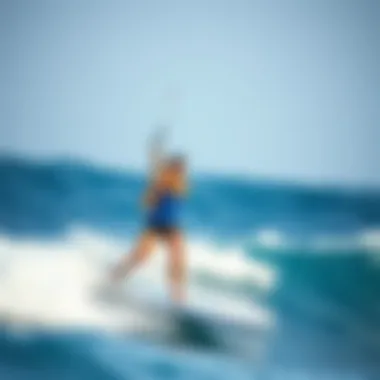Maximize Your Surf Skills with Paddle Exercises


Intro
The surf paddle exercise stands not only as a training regimens but as a bridge between the beach and the break. Imagine standing on your board, staring down the expanse of water, contemplating the myriad of waves ready to swallow you whole. Before that exhilarating moment, one must master the paddle stroke, a critical step that establishes fundamental skills for every surfer. This guide is designed for both budding enthusiasts and seasoned pros looking to sharpen their skills.
Why Focus on Paddle Technique?
The paddle stroke isn’t just about moving forward; it’s the cornerstone of confidence in surfing. A well-executed paddle helps maintain balance and stability on the board. Highlights of this guide include:
- Essential techniques to enhance your paddle strokes.
- Physical benefits tied to the surf paddle exercise, promoting better endurance and strength.
- A glimpse into common misconceptions like the idea that only upper body strength counts—it's a full-body endeavor, after all.
By incorporating paddle exercises into your surf training, you will not only see an improvement in your performance but also in your overall fitness. Each wave becomes a challenge met with knowledge, strategy, and the proper technique.
The Importance of Surf Paddle Exercises
Surfing is more than just riding waves; it's an intricate dance between physical strength, endurance, and technique. One of the foundational elements that contributes significantly to a surfer's success is the surf paddle exercise. In this section, we delve into why focusing on paddle exercises is crucial for anyone looking to enhance their performance in the water.
Enhancing Upper Body Strength
Engaging in surf paddle exercises is akin to forging an unbreakable chain; each link amplifies your upper body strength crucial for paddling out past the break. When you consistently perform these exercises, you build muscle in your chest, shoulders, and arms. Techniques like the traditional paddle stroke and more intensive drills, such as the one-arm paddle, allow you to target specific muscle groups effectively.
- Push-ups and Pull-ups: Incorporating these can provide additional strength to your upper body, translating directly to more powerful paddles.
- Resistance bands: They can be effective too. Some surfers swear by band resisted paddling to build functional strength imitating the paddling motion.
Regular practice not only helps in creating power but also promotes better form, which reduces fatigue over longer sessions and contributes immensely to more controlled turns while catching waves.
Improving Stamina and Endurance
Imagine battling against unforgiving waves for hours, deeply immersed in the pursuit of the perfect ride. Paddle exercises fortify your stamina and endurance, ensuring that fatigue doesn't cramp your style on the surfboard. The aerobic capacity established through dedicated paddling routines equips you to endure longer in the water without losing energy.
For effective stamina building:
- Interval Training: Consider alternating between high-intensity drills followed by rest periods. This mimics the bursts of energy required while surfing.
- Paddle for Distance: Regularly practicing long, sustained paddling not only enhances cardio but also conditions your muscles for prolonged exertion.
Over time, improved stamina translates to an effortless glide through waves. Many surfers find that after integrating paddle conditioning into their routines, they can stay out longer, which often leads to a higher number of rides per session.
Boosting Balance and Coordination
In the world of surfing, balance is king. Paddling itself is a fine-tuned act of coordination involving the upper body while stabilizing the core and legs. The right paddle exercises extend beyond mere strength training; they encourage better body awareness, allowing surfers to stay balanced on the ever-shifting sea surface.
To get a leg up on balance:
- Balance Drills: Incorporate exercises, such as balancing on a stability ball while mimicking paddle strokes, to enhance coordination. This also encourages engagement of the core muscles, central to good posture on the board.
- Combine with Yoga: Many surfers partake in yoga sessions to improve flexibility and balance. Paddling paired with yoga fosters a holistic approach to body control.
By focusing on these attributes through surf paddle exercises, surfers become more adept at adjusting their stance and movements in response to the dynamic nature of the ocean. Every stroke then becomes an intentional action that not only propels them forward but also helps maintain stability on the board.
Regular paddle exercise lays the groundwork for improved performance, endurance, and balance, turning good surfers into exceptional ones.
Key Techniques for Effective Paddling
Understanding the right paddling techniques is crucial for surfers aiming to maximize their performance in the water. When executed properly, these techniques can prevent fatigue, enhance speed, and improve overall maneuverability, laying the foundation for a strong surfing experience. Paddling effectively not only helps in catching waves more easily but also allows one to conserve energy during long sessions. Here, we explore several key techniques that are invaluable for surfers.
Correct Body Positioning
Achieving the right body position on the board is paramount. Many novice surfers often fumble with their posture, either too far forward or too far back. A proper body position will ensure effective paddle strokes and an optimal angle for catching waves. Ideally, the chest should rest on the board, allowing your hips to be low and your feet to provide stability at the tail of the board.
- Head up, eyes forward: Always look ahead and keep your head up. This not only helps in spotting incoming waves but also keeps your body aligned for better balance.
- Feet placement matters: Position your feet well. A common mistake is placing them too close together. Instead, placing them shoulder-width apart provides maximum stability.
Proper body positioning is essential for generating speed while paddling and increases your ability to control the board when a wave approaches.
Optimal Paddle Strokes


Paddle strokes are where the core of the paddling technique lies. They determine how effectively a surfer can navigate the waters. Knowing how and when to stroke can set someone apart from the rest.
Understanding Long vs. Short Strokes
Long strokes utilize larger movements that are beneficial in covering more distance quickly. When you’re aiming to catch a wave, a long stroke helps position your board correctly. The key characteristic of long strokes is reach; stretching your arm out fully as you plunge the paddle into the water maximizes each stroke’s potential.
In contrast, short strokes often come into play when making quicker adjustments or when you need to maintain balance without exerting too much energy. The benefit here is maneuverability. Surfers should mix these strokes according to the scenario, adapting to the conditions and their needs in the moment.
"Mastering the art of stroke length can be the difference between a perfect ride and a missed wave."
Incorporating Power and Speed
Incorporating power into your strokes while maintaining speed can drastically improve paddling effectiveness. Using your core and large muscle groups, rather than just your arms, creates a more powerful stroke. When you push down on the paddle with your core engaged, you're able to draw more water, propelling your body and board forward efficiently.
Striking the right balance between speed and power is vital. While a fast paddler may be quick off the mark, lacking power can leave you struggling in more challenging conditions. Conversely, focusing solely on power without speed could leave you lagging behind during wave take-offs. Understanding how to meld these elements makes each paddling session more impactful.
Breathing Techniques
Breathing techniques in paddling are often overlooked but play a crucial role in maintaining endurance. Just as in any aerobic activity, rhythmic breathing will optimize oxygen intake and keep your body energized. Try to synchronize your breathing with your paddle strokes, inhaling during the stroke recovery phase and exhaling during the entry phase. This method keeps your lungs filled and your energy levels high, enhancing performance over longer periods.
Also, mindful breathing can help reduce anxiety, particularly in competitive environments. When the waves are crashing and adrenaline is high, calming your breath can keep you focused on what truly matters - catching that wave.
The key techniques for effective paddling encompass not just the physical mechanics, but also the mental clarity that comes with understanding one’s body and its capabilities. Mastering these techniques can transform not only a surfer’s performance but also their experience on the water.
Common Mistakes in Paddle Exercises
When it comes to surf paddle exercises, a few missteps can lead to setbacks in both skill and fitness. Acknowledging common mistakes helps surfers avoid traps that could hinder progress. By examining these errors, you can refine your technique, bolster endurance, and ultimately enhance your surfing experience. Here’s a closer look at some widespread pitfalls.
Overexertion and Fatigue
One major blunder surfers often face is pushing beyond their limits, resulting in overexertion and fatigue. It’s easy to get carried away, especially when enthusiasm is high, but it’s vital to listen to your body. Coming into a session feeling drained or overworked can lead to sloppy paddling, which not only diminishes performance but can lead to injuries. Recognizing your energy levels is crucial, as it allows for more targeted practice and minimizes the risk of burnout.
- Signs of Overexertion:
- Increased heart rate beyond comfortable limits
- Difficulty maintaining proper paddle form
- Pain or strain in muscles or joints
To sidestep this issue, it’s wise to set achievable goals for each practice session and gradually build intensity. Remember, it’s about longevity in the water, not just a one-time push.
Ignoring Core Engagement
Executing paddle strokes effectively requires more than just upper body strength. A common error is neglecting core engagement. Many surfers underestimate the role of the core in stabilizing and powering paddle strokes. An unengaged core can lead to ineffective paddling, as the body loses the necessary balance and coordination that comes from a strong core.
- Benefits of Core Engagement:
- Improved stroke efficiency
- Enhanced balance on the board
- Reduced risk of injury
You don't have to be a gym rat to work on your core; simple exercises like planks, leg raises, or even yoga can increase core strength. Integrating these into your routine will yield dividends when you’re out on the waves.
Poor Paddle Mechanics
Sometimes, it’s not just about how strong you are, but how efficiently you paddle. Poor paddle mechanics can severely limit your potential. Surfers may fall into the habit of paddling incorrectly, either by using too much strength or adopting an improper stroke pattern. This inefficiency not only robs energy but can also affect speed and maneuverability in the water.
To combat this issue, focusing on the following aspects can be beneficial:
- Paddle Stroke Technique:
- Entry: Ensure your hands enter the water straight in front of you.
- Pull: Pull through the water with a long arc rather than chopping or short strokes.
- Exit: Release the paddle cleanly from the water, without splashing.
Focusing on proper mechanics can transform your performance from average to exceptional. Take time to practice these strokes on flat water, which will allow you to hone your skills without the chaos of waves disrupting your technique.
"Good mechanics in paddling not only boost performance but provide a solid foundation for advanced surfing tricks."


Lastly, keep in mind that consistent practice and mindfulness about these common mistakes lead to more effective training and better surfer overall.
Integrating Paddle Exercises into Training Routines
Integrating paddle exercises into your training routine holds critical significance for anyone looking to elevate their surfing prowess. It's like finding the missing piece of the puzzle that ties together strength, stamina, and skill in the water. Let’s navigate through how to effectively blend these exercises into a comprehensive training framework that not only complements your surfing but also enhances overall performance.
Creating a Balanced Workout
A balanced workout is the bedrock of any effective training routine. When we talk about a balanced approach, we mean combining different types of exercises that target various muscle groups, ensuring your body remains agile and strong. To create this blend, it’s essential to include paddle exercises, strength training, and flexibility work.
Benefits of a Balanced Workout:
- Muscle Development: Builds strength in your upper body, core, and legs.
- Injury Prevention: A well-rounded workout minimizes the risk of overuse injuries common among surfers.
- Enhanced Performance: Each workout element contributes to smoother paddling, better wave catching, and overall enjoyment of the sport.
Supplementary Exercises for Surfers
In the quest for surf excellence, supplementary exercises can propel your paddle workouts even further. These exercises can support paddling workouts in unique ways, boosting your overall capacity and skill.
Strength Training
Focusing on strength training is vital for any athlete, but especially for surfers. Strength training encompasses various exercises, like resistance training, that targets major muscle groups used in surfing. This aspect of your training is about building raw power; it prepares your muscles for the robust demands of paddling out and maneuvering through waves.
Key Characteristics of Strength Training:
- Tailored to Surfing: Exercises such as bench presses, squats, and pull-ups are particularly conducive to enhancing surfing performance.
- High Load Capacity: Developing the muscles’ ability to handle high loads translates to more powerful strokes and endurance.
While strength training is beneficial, it’s crucial to balance it with other modalities to avoid muscle fatigue. An overload can lead to wear and tear, which you definitely want to steer clear of while out in the water.
Flexibility and Mobility Work
Flexibility and mobility work may often fly under the radar in an athlete's training regimen, yet they play a pivotal role for surfers. These exercises help maintain the range of motion in your joints and enhance your body's ability to perform complex movements required during surfing.
Unique Features of Flexibility and Mobility:
- Joint Health: A flexible body can perform more efficiently and remain injury-free.
- Fluid Movement: Proper mobility helps in agile wave maneuvering, thus improving overall surf ability.
However, a word of caution - neglecting strength and endurance training while focusing solely on flexibility can lead to an imbalance. It’s essential to keep a varied approach that respects all aspects of your body’s capabilities!
Evaluating Progress
Evaluating your progress is not just about tracking how many waves you catch during a session but also understanding how paddle exercises influence your surfing journey. Implementing regular check-ins with your training goals will help keep you on track, reflect on what’s working, and allow for the adjustments necessary to maximize your performance.
In summary, integrating paddle exercises into training routines is a vital concept that can significantly boost your surfing ability. Creating a balanced workout, incorporating strength and mobility work, and continuously evaluating your progress will ultimately set you on track for becoming a better surfer. Keep at it, and remember - every paddle stroke counts!
Safety Considerations While Paddling
When it comes to surf paddle exercises, safety should always be at the forefront of any training routine. The thrill of paddling out on the waves often overshadows the fundamental aspects of safety. However, understanding the nuances of safety can significantly impact overall performance and health in the long run. This section will cover key elements that every surfer should consider to ensure effective and safe practice of their paddle techniques.
Recognizing Physical Limits
Every athlete has a breaking point, and knowing when to push through discomfort versus when to heed the warnings of fatigue is crucial, especially during paddle exercises. It's not just about enhancing strength and endurance but also about protecting oneself from injuries. Overdoing it can lead to strains or even serious injuries, potentially sidelining you for weeks.
When you push too hard, your body begins to signal distress. Look for signs like unusual fatigue, persistent aches, or even altered paddling technique. It might be tempting to disregard these warnings in the quest for improvement, but understanding your physical limits can set the foundation for sustainable progress.
Some tips include:
- Start Slow: Gradually increase the intensity of your workouts to avoid strain.
- Listen to Your Body: If something doesn’t feel right, it’s worth taking a step back.
- Consult a Professional: A coach can help identify your limits and suggest safe progression.
Choosing the Right Environment
The environment where you choose to paddle can drastically affect your safety. Conditions like wind, tide, and wave height should all be factored in before you grab your board. Engaging in paddle exercises in rough waters can not only jeopardize your training but also put your safety at risk.


It’s essential to familiarize yourself with local surf conditions. This means not just checking out what the waves look like but also noting any potential hazards like rocks, currents, and local marine life. Prioritize safe areas like designated surf spots that are suitable for your skill level. Some practical considerations include:
- Check Weather Reports: Know what to expect before you go.
- Stick to Familiar Waters: If you're new to paddling or still improving your skills, it’s wise to practice in waters you know well.
- Buddy System: Whenever possible, paddle with a friend. It adds a layer of safety to help in case of emergencies.
Importance of Hydration
While it might seem like a minor detail, staying hydrated can make a world of difference when engaging in surf paddle exercises. Dehydration not only impacts physical performance but also can affect mental clarity and reaction times. This can become a detriment, especially in the water where quick decisions are crucial.
Make it a habit to hydrate before, during, and after your paddle sessions. Carrying a water bottle in a waterproof case while you train can serve as a constant reminder to replenish your fluids. Here are some essential hydration tips:
- Drink Before You’re Thirsty: Don’t wait to feel thirsty to drink.
- Electrolyte Drinks: Consider drinks that replace lost electrolytes from sweating, especially on hot days.
- Timing: Aim to hydrate a few hours before your session for the best results.
Staying vigilant about these safety considerations can greatly enhance your paddle training while reducing the risk of injury and ensuring a more rewarding surf experience. Taking your paddle practice seriously is about longevity in the sport and fostering a passion that lasts a lifetime.
For more information on surf safety, consider visiting sites like surflifeguards.net or check resources on weather conditions for surf-friendly spots.
The Role of Surf Paddle Exercises in Competitive Surfing
When it comes to the adrenaline-soaked world of competitive surfing, every little detail plays a role in determining an athlete's success. Surf paddle exercises stand out as a cornerstone of training for serious surfers. They do not just build physical strength but also aid in developing a surfer's mental edge, which is often the differentiating factor in high-stakes competition.
Training for Performance
To really dig into the nuts and bolts of paddle exercises, one must recognize how they fundamentally enhance performance. For surfers, the ability to paddle swiftly and efficiently means catching waves at just the right moment. This is especially crucial when battling against other competitors in the lineup.
Let’s break down some key aspects related to performance enhancement through surf paddle exercises:
- Upper Body Power: Surf paddle exercises hone key muscles in the shoulders, arms, and back. This building of muscle not only aids in paddling faster but also plays a significant role when it comes to vigorous pop-ups during wave riding.
- Stamina: Competitive settings demand high endurance, given the often unpredictable nature of waves. By integrating specific paddle drills into training, surfers can delay fatigue and sustain energy levels, allowing them to outlast their opponents during heats.
- Muscle Memory: Critical to competitive surfing is the concept of muscle memory. Just like a pianist practicing scales, a surfer who regularly engages in paddle exercises can react instinctively. This sharp response time becomes invaluable during competitions, where every second counts.
"In competitive surfing, the real challenge often lies in outpaddling your rivals to catch the best waves."
By leveraging these exercises, surfers can improve their technical skills, but physical training alone won’t carry the day.
Mental Preparation and Focus
A strong mind can be just as vital as a powerful body when facing the rigors of surf competitions. Mental preparation and focus play a significant role during competitions, and paddle exercises contribute here as well. As surfers refine their paddling techniques, they indirectly bolster their mental game.
Here’s how surf paddle exercises enhance mental readiness:
- Mindfulness: Engaging in paddle workouts can be meditative, providing surfers a chance to focus their minds and block out distractions. The rhythm of paddling creates a state where one can reflect on techniques and visualize successful rides.
- Confidence Building: Through consistent training, surfers can witness tangible improvements. This progression leads to increased self-belief and confidence on competition day. Just knowing they’ve put in the work often gives them an edge.
- Stress Management: Competitive surfing naturally comes with its share of pressure. Paddle exercises, particularly when done in a group or under the guidance of a coach, can also foster a sense of camaraderie, easing anxiety that may build up around competitions.
Ending: The Future of Surf Paddle Conditioning
As the surfing world continues to evolve, the significance of surf paddle exercises isn't fading into the background. Instead, it’s gaining momentum, highlighting its crucial role in a surfer’s journey both on and off the waves. When we consider the technical advancements in surfing equipment and techniques, it’s evident that paddling remains the backbone of effective surf performance.
Evolving Techniques and Training
The way we approach surf paddle conditioning is changing. No longer are we just focusing on brute strength or simple endurance; it's about smart training. Surfers now look to integrate diverse methods that incorporate functional movements, agility drills, and innovative paddle techniques.
Key points to consider include:
- Cross-training Practices: Incorporating yoga for flexibility, resistance bands for strength, and even swimming for general stamina. Each practice contributes to a well-rounded conditioning regime.
- Technology Utilization: Tools like paddle simulators or digital performance monitoring can help track improvement and tailor individual workouts.
- Technique Refinement: Continued focus on paddle mechanics, like grip and stroke variation, can enhance efficiency and decrease the risk of injury.
All these elements suggest a bright future for paddle conditioning, where adapting to change is as significant as mastering the basics. Surfers owe it to themselves to embrace these developments to navigate the surf more effectively.
Staying Informed with Research
It's one thing to incorporate new techniques, but staying updated on the latest research is equally essential. The scientific community constantly seeks to unlock the mysteries behind physical activity and performance. Different studies shine a light on how specific training regimens can optimize paddling efficiency.
Consider these points for keeping abreast of developments:
- Follow Academic Journals: Many publications focus on sports science, providing valuable insights into athletic training methods and injury prevention. Journals like the Journal of Sports Sciences or Sports Medicine provide data-backed content.
- Connect with Online Communities: Platforms that cater to surfers and athletes discuss tips and findings that can aid in personal development. Websites like Reddit or dedicated forums are goldmines for shared experiences and strategies.
- Attend Workshops and Seminars: Engaging with experts through training camps or seminars can provide direct access to information and allow surfers to ask questions about their specific needs.
In the ever-changing landscape of surf conditioning, a commitment to research and continued education is paramount. Surfers who invest time in understanding the science behind their sport can expect to master not only their paddling but their entire surfing experience.
In essence, the future of surf paddle conditioning is bright and full of possibilities. By embracing new techniques and staying informed, surfers can enhance their performance and enjoy a more enriched experience on the water.
Embracing change and knowledge in surf paddle exercises sets the stage for the next wave of surfing excellence. The future belongs to those who paddle not just hard, but smart.







